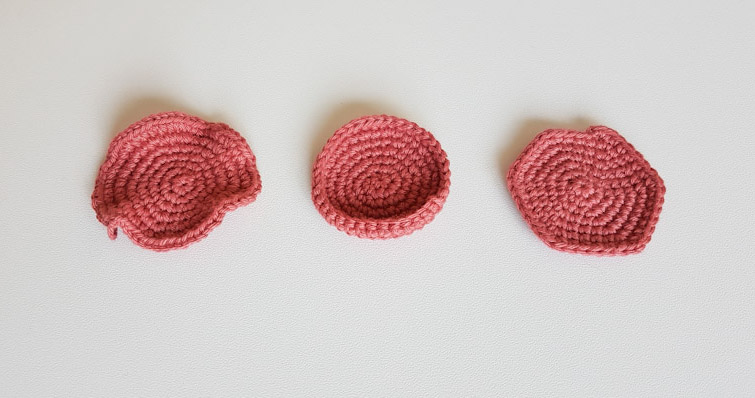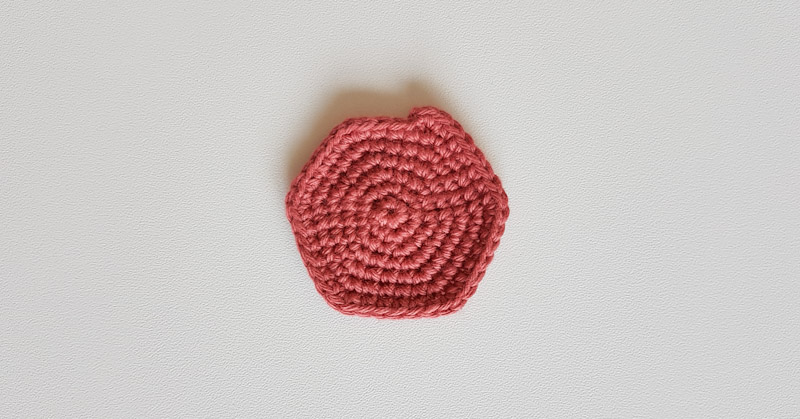When working in the round, it’s essential to know how to increase. You need to be able to increase if you crochet a ball or other round shapes.
Do you know how to make a magic ring?
This blogpost has pictures showing a circle, worked as a spiral, and not a circle, where each round is finished. You can use this guide, no matter if you finish each round with a slip stitch or you work in a spiral.
Increases
When you have made your magic ring and you start to make your circle bigger, then it’s crucial that you know how - and when – you work your increases. Therefore, I made a little guide, which I hope can help you to create the perfect circle.
The technique for increasing is pretty simple – you just work two stitches in one existing stitch. But it may be a challenge to know when you need to increase in order to create a pretty and smooth circle. You often begin by making a magic ring with either 4 or 6 single crochet (= sc) in it.
The rule is, that you increase on each round with the same number of stitches you begun with in your magic ring.
I’ve made a table, showing you how many stitches, you need to have per round and also where you make the increase.
Magic ring: 4 sc
Round 1: 8
Round 2: 12
Round 3: 16
Round 4: 20
Round 5: 24
Round 6: 28
Round 7: 32
Round 8: 36
Magic ring: 6 sc
Round 1: 12
Round 2: 18
Round 3: 24
Round 4: 30
Round 5: 36
Round 6: 42
Round 7: 48
Round 8: 54
To increase with 4 or 6, then you always need to work two stitches in each existing stitch on the first round. In the next rounds you work your increases according to a specific pattern – see my example here:
Magic ring:
Round 1: Inc in all sts
Round 2: 1 sc, 1 inc
Round 3: 2 sc, 1 inc
Round 4: 3 sc, 1 inc
Round 5: 4 sc, 1 inc
Round 6: 5 sc, 1 inc
Round 7: 6 sc, 1 inc
Round 8: 7 sc, 1 inc
In round 8 the table shows, that you need to work 7 sc and 1 increase. This means, that you work two sc in the 8th stitch. In this way you expand the circle and make it bigger. If you began with 6 sc, then you need to have 54 stitches after round 8. So, to get the 54 sc on round 8, you need to increase your circle by working 7 sc and 1 increase on entire round – until you have a total of 54 stitches. It’s a good idea to use a stitch marker at the beginning of the round. Then you don’t need to count all the time.
Doesn’t your circle become entirely round and smooth?
That’s a problem many encounter – me included. You can experience that the piece is wavy, the edges curl or the shape is more a hexagon than a circle. But don’t worry, there’s a solution to all these little problems.

If your piece is wavy, it may be that you made too many increases per round – you increased with more stitches than necessary. The only solution is to unravel and go back to where the piece is smooth and start over. Sometimes, you may be lucky with just working a couple of rounds without increasing. But it’s more the exception, than the rule, that this will succeed. You may also try to work with a smaller hook, as a wrong hook may cause the piece to become wavy, even though the increases are correct. Does the edges curl? This may happen if you didn’t increase with enough stitches, and the only solution is unfortunately to unravel and go back to where the edges don’t curl anymore. If you used a too small hook, the piece may also curl. Switch to a suitable hook size, that is recommended with the yarn – you can find it on the yarn label.
Is your circle angular?

If your circle looks more like a hexagon, than a circle, then it doesn’t necessary mean, that you made a mistake. When increases are made on top of each other, then the piece may become angular. To avoid this, you can move the increases and spread them on the round. You can start moving the increases as you see that your circle becomes angular. For example, you need to work a round with 7 sc - 1 increase, then you can begin the round with 1 increase and here after work the 7 sc. You can also work a couple of sc - 1 increase, and then continue as usual with 7 sc - 1 increase. This means, you will move all increases on the round. It’s not important, where you begin increasing or where you place them, as long as you make sure, that you get the right number of stitches on the round. If you are used to finish with an increase, it may be a bit difficult to know where the round ends or begins, when you want to move the increases. To make sure you know where the round begins and ends, you can place a stitch marker in the first stitch on the round.
As I wrote earlier, the pictures show a circle worked in a spiral. But to show you the difference, I have also worked a circle, where each round is finished with a slip stitch.

The first circle on the picture is worked as a spiral. You can recognize it on, that the round goes on and on and there’s no visible transition between each round. The second circle is worked with finished rounds. Here you finish each round with a slip stitch and each new round begins with a chain stitch. When you finish each round, you will get a visible transition, that runs through entire piece.
I really hope you could use this blogpost, and that the tables have given you a clear method on how to work in the round – In any case, that was my intention! When I work in the round, and I don’t have a pattern, I also use these tables. I recommend that you save this blogpost and return to it, the next time you need to work in the round. I can assure you, you will need it ;-)
Love from
Josefine, Hobbii
